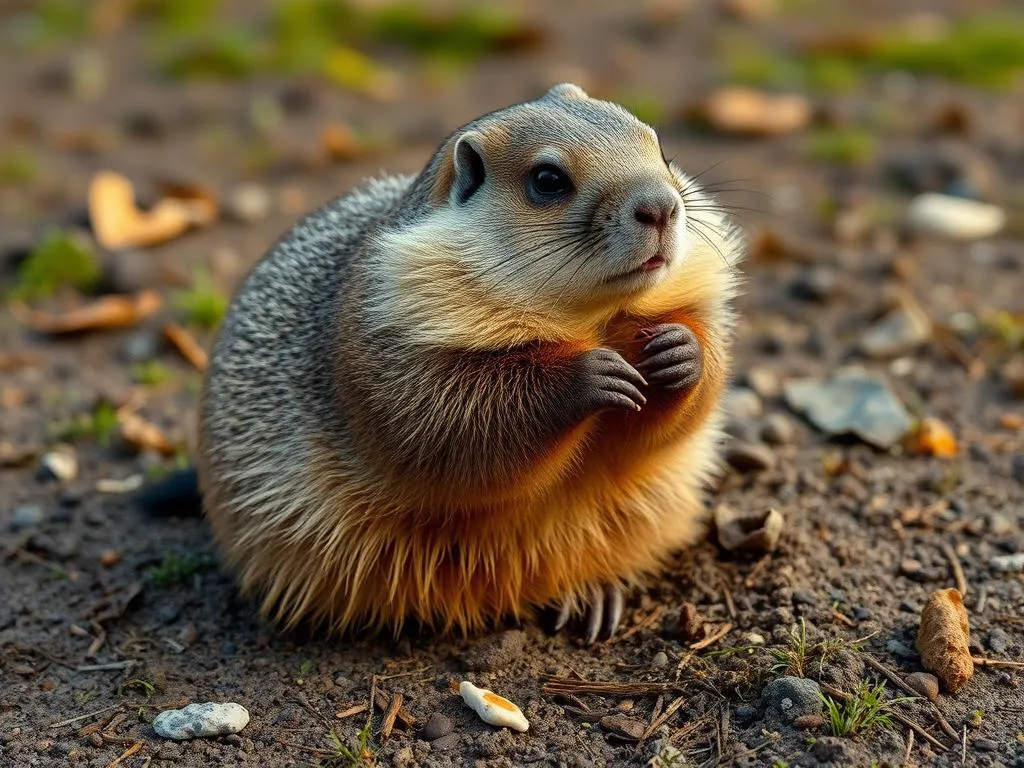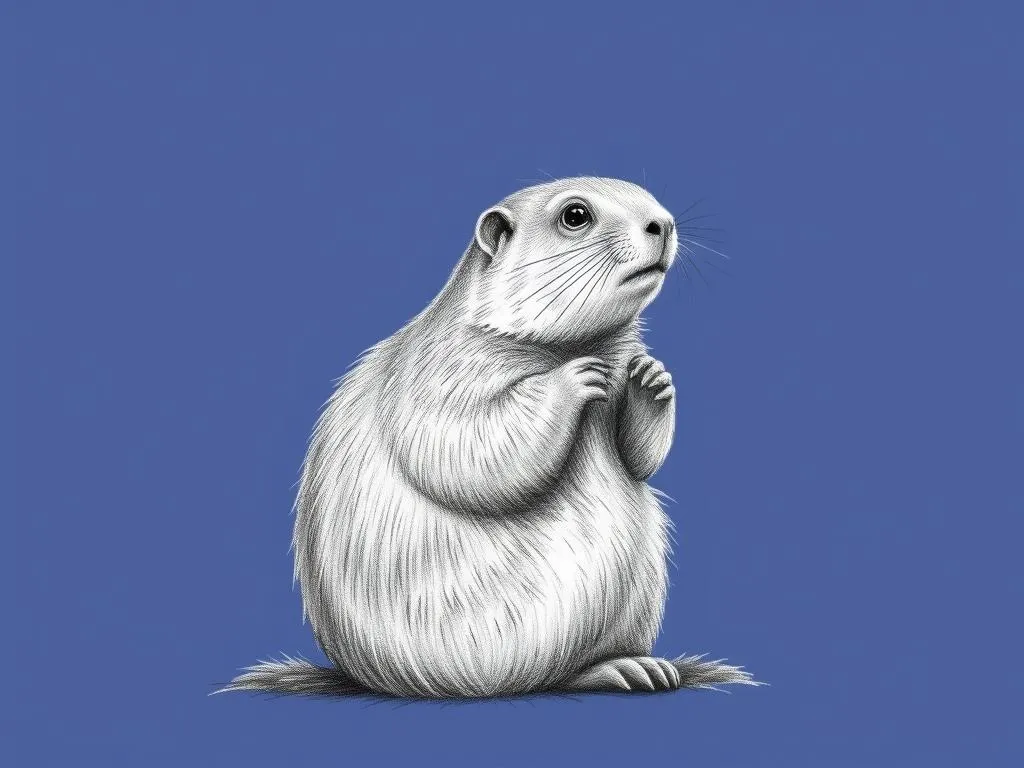The Groundhog: A Symbol of Transformation and Renewal

Disclaimer: Some images on this website are AI-generated artworks and may not accurately represent real animals.
Groundhogs, often seen as simple creatures of the wild, carry deep symbolism and meaning that resonate with themes of transformation and renewal. These small, furry mammals are not only fascinating in their natural behavior but also rich in cultural and spiritual significance. In this article, we will explore the groundhog’s physical characteristics, its role in the ecosystem, and the profound symbolism associated with this remarkable animal.
Understanding the Groundhog
Physical Characteristics and Habitat
Groundhogs, also known as woodchucks, belong to the rodent family and are easily recognizable. Here’s a brief overview of their physical characteristics:
| Feature | Description |
|---|---|
| Size | 18 to 24 inches long, weighing 5 to 14 pounds |
| Fur | Thick, coarse fur, typically brown or gray |
| Tail | Short, bushy tail about 4 to 7 inches long |
| Teeth | Prominent, chisel-like incisors for gnawing |
Groundhogs are primarily found in North America, inhabiting areas such as fields, forests, and gardens. They prefer environments with plenty of vegetation and burrowing spaces. Their burrows can be quite elaborate, featuring multiple chambers and entry points, which serve as protection against predators.
Behaviorally, groundhogs are diurnal, meaning they are active during the day and rest at night. They are excellent diggers and spend a significant amount of time foraging for food, primarily consisting of grasses, fruits, and vegetables.
Role in Ecosystem
Groundhogs play a vital role in their ecosystems. As herbivores, they contribute to the health of vegetation by controlling plant growth. Their burrowing habits aerate the soil, promoting better drainage and improving nutrient circulation. This activity not only benefits plants but also creates habitats for other organisms.
Moreover, groundhogs serve as a food source for various predators, including foxes, hawks, and coyotes, thus maintaining the balance within their ecosystem. Their presence is essential for promoting biodiversity and healthy soil, making them significant players in their natural habitat.

Symbolism & Spiritual Meaning
The Groundhog as a Harbinger of Change
One of the most notable aspects of groundhog symbolism and meaning is their association with change, particularly seasonal transitions. The groundhog’s emergence from hibernation is celebrated annually on Groundhog Day, a cultural event that has gained popularity in North America. This day symbolizes the end of winter and the promise of spring, reflecting the groundhog’s role as a harbinger of change.
Groundhog Day is steeped in tradition, where the groundhog’s shadow—or lack thereof—is interpreted as a sign of the coming weather. If the groundhog sees its shadow, it is believed that six more weeks of winter will follow. Conversely, no shadow indicates an early spring. This event has become a metaphor for hope and renewal, emphasizing the cyclical nature of life.
Themes of Grounding and Stability
Groundhogs are earth dwellers, and their behavior is often associated with grounding energy. They spend much of their lives underground, providing them with a deep connection to the earth. This connection symbolizes stability and the importance of being rooted in one’s environment.
The concept of hibernation is also significant in groundhog symbolism and meaning. Hibernation represents a period of rest and renewal, allowing the groundhog to conserve energy and survive harsh conditions. In a broader sense, it encourages individuals to embrace periods of introspection and self-care, promoting personal growth and transformation.
Groundhog in Dreams
Interpretations of Groundhog Dreams
Dreams involving groundhogs can be rich with meaning. Seeing a groundhog in a dream may symbolize various life themes. Here’s a table summarizing some interpretations:
| Dream Scenario | Interpretation |
|---|---|
| Groundhog emerging from a burrow | Awakening to new possibilities or changes in life |
| Groundhog hibernating | Need for rest or introspection |
| Groundhog interacting with other animals | Social connections and community bonds |
| Groundhog digging | Efforts to uncover hidden aspects of oneself |
These dream scenarios often reflect awareness of cycles and the importance of understanding one’s environment. Groundhogs in dreams may serve as reminders to pay attention to personal growth and the transitions occurring in life.
Personal Reflection and Growth
When a groundhog appears in dreams, it can symbolize a journey of personal transformation. The themes of change and renewal resonate deeply, prompting individuals to reflect on their current circumstances and the potential for growth. Dreams featuring groundhogs encourage introspection, inviting dreamers to consider areas in their lives that may need attention or change.
For many, groundhog dreams may also signify the importance of patience. Just as groundhogs take their time to emerge from hibernation, individuals may need to allow themselves the grace of time to grow and evolve. This reflection can lead to profound insights and personal development.
Modern Interpretations
Groundhogs in Popular Culture
In contemporary society, groundhogs have found their way into popular culture, often represented in media and folklore. Groundhog Day has transcended its original roots, becoming a symbol of hope and anticipation. Movies and stories have portrayed groundhogs as whimsical creatures, emphasizing their role in marking seasonal changes.
The celebration of Groundhog Day has evolved into a community event, drawing crowds eager to witness the groundhog’s prediction. This annual tradition serves as a reminder of the cyclical nature of life and the importance of community gatherings, reinforcing social bonds.
Symbol of Environmental Awareness
In recent years, groundhogs have also become symbols of environmental awareness. As indicators of ecological health, their presence can signal changes in the environment. Groundhogs are sensitive to habitat loss and climate change, making them valuable subjects of study in assessing ecosystem health.
Their role in discussions about biodiversity and conservation highlights the interconnectedness of all living beings. By observing groundhogs and their behaviors, individuals can gain insights into the state of their environment, fostering a deeper appreciation for nature and its cycles.
Key Takeaways
Understanding the symbolism and meaning of groundhogs provides valuable lessons for personal and ecological growth. Here are the key takeaways:
- Groundhogs symbolize transformation and renewal, reflecting the seasonal cycles of life.
- Their hibernation and emergence signify the importance of patience and introspection during periods of change.
- Groundhogs play a crucial role in their ecosystems, emphasizing the need for biodiversity and environmental health.
- They serve as reminders to stay grounded in one’s life journey, promoting stability and connection to the earth.
- Groundhog Day celebrations highlight the importance of community and the collective experience of anticipating change.
Conclusion
In conclusion, the groundhog stands as a powerful symbol of change, grounding, and renewal. Its behaviors, from hibernation to emergence, reflect the cycles of life that we all experience. By observing these remarkable creatures and embracing the lessons they embody, we can gain deeper insights into our personal growth and transformation.
The significance of groundhogs extends beyond mere folklore; they remind us to tune in to the rhythms of nature and to honor the changes that shape our lives. As we engage with the natural world, we open ourselves to the possibilities of renewal and the beauty of transformation.







